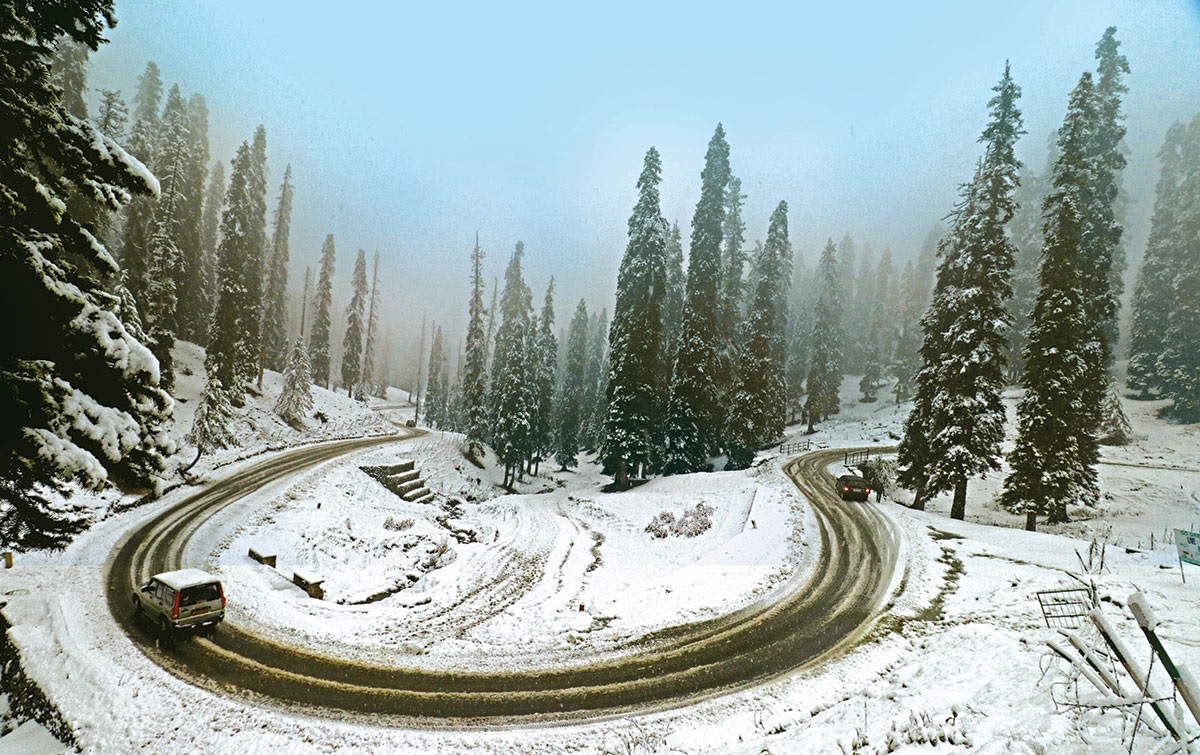As the government works on the restoration of Kalai of the heritage Naagar Nagar city experts say it is being done in a flawed manner and may not bring the desired results, Junaid Nabi Bazaz reports
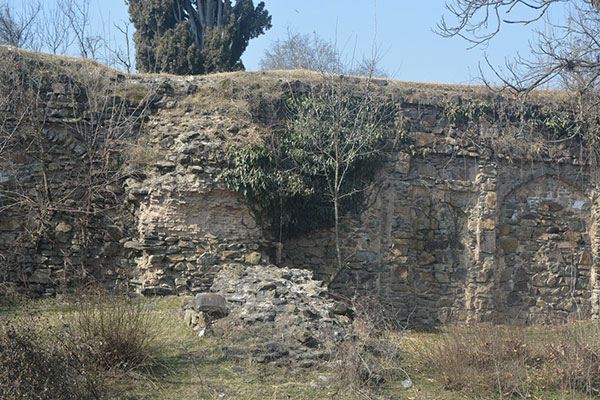
The state’s tourism department has started restoration work of the Kalai – the fence wall of historic Naagar Nagar in Srinagar, however, experts say it would not change much as the heritage site has heavily been encroached upon, which need to be removed first.
The Naagar Nagar city built by Mughal Emperor Akbar in the lap of Hariparbat hill and secured by a huge fence wall (known locally as Kalai) has been lost to public greed and official apathy, say historians.
Kalai literary means a ‘strong wall’. Akbar, after seizing Kashmir, built the Naagar Nagar city and fenced it with a huge wall to secure his coterie and his troops.
“Kashmiris were against the Mughals and had bravely challenged their assaults. Akbar settled his soldiers behind the Kalai to prevent skirmishes with local population,” says historian Prof Fida Hasnain. “Kashmiris while fighting against the Mughal invasion had left their work including agricultural activities. This had affected their economic condition and the problems were compounded by draught and paucity of food. He wanted Kashmiris to concentrate on economic activities. So he decided to build a walled city. He had named this settlement as Naagar Nagar,” Hasnain said.
Due to its heritage value, the state government declared Kalai a protected monument in March 2010. Earlier the Kalai was being protected under a Central Act, which provided legal protection to only two gates of Kalai (Mughal Rampart) -Sangen Darwaza and Kathi Darwaza- besides barring any construction within 100 meters and regulating constructions in the next 100 meters.
Convener Indian National Trust for Art and Culture Heritage (INTACH), Saleem Beg says that the ‘protection act’ came when the kalai has been completely vandalized.
“Out of the original 4.8 Km of periphery only 3.3 Km are left, 0.826 Km are completely missing and .719 damaged. The figures reveal the extent of vandalisation of the Kalai,” says Beg. “There has been a complete change in the topography of the Kalai over the years. Even the ruins of gardens built by Mughals near Kathi Darwaza do not exist now. The watchtowers are either missing or damaged.”
Apart from the neglect and vandalisation, massive encroachments have eaten away the Kalai so much that it is not visible from the inside.
Abdul Ahad Makhdoomi, 70, whose ancestors have been living inside the Kalai for centuries says, “Just few yards away from Kathi Darwaza encroachers have constructed many houses on the top of Kalai.”
The houses made of tin sheets and plywood are let on rent – mostly to labourers from outside the state.
Rahat Ded (name changed) had shifted from Bemina Srinagar to a house near kalai in ‘90’s.
Sitting on the provisional store which is also the ground floor of her two storied old house, Rahat Ded recollects, “This area was not congested when I came in to live here as it is of now.”
Riyaz Ahmad, a resident near Kathi Darwaza-Main gate of Kallai- says that the encroachers have even encroached on the roads leaving “little space for pedestrians”. “Even small cars pass through with difficulty,” says Riyaz.
Historians say that the encroachment started when China came under the influence of Communism, inhabitants of Muslim majority Xinjiang province rebelled against it. Thousands were killed and thousands others migrated to Kashmir via Tibet and Ladakh.
“At that time (chief minister) Sheikh Mohammad Abdullah formed a committee and selected Bakshi Ghulam Mohammad to head it for their rehabilitation who chose interiors of kalai for their settlement,” says Hassnain.
The State government latter relocated them inside Sangeen Darwaza which now a days has turned into a complete locality called as Tibitian colony.
Ram Chander Kak described the Sangin Darwaza (stone gate) as more ornate than rest of its gates in his book Ancient monuments of Kashmir. Its exterior is decorated by two corbelled windows with two stairs, one on each side giving access to the roof.
President of Koh e Maran Coordination committee and Social activist, Zareef Ahmad Zareef says, “In 1975 Sheikh Mohammad Abdullah housed some homeless people near Kathi Darwaza without keeping in mind the sanctity of this archeological monument and over these years their number has reached to near 3600 families.
“Their housing was not meant for rehabilitation but vote bank politics.”
As per the state’s protection act the construction within 100 meters of Kalai is prohibited.
Beg says, “To restore Kallai, as per the act, all the constructions within 100 Meter must be removed.”
The constructions made before 1992 should be relocated and the construction formed afterwards must be demolished. But so far on the ground neither any demolition nor any case of relocation has been carried away, he says.
However, in October 2011, the tourism department initiated the process of repairing the damaged part of kalai, eighteen months after JK Ancient Monument Protection Act was passed. The union government in June 2011 also sanctioned Rs 50 crore for its restoration.
But experts say the efforts will be ‘useless’ until the encroachers are displaced. “What is the fun of repairing the kalai when the encroachers are not moved?” asks Deputy Director Archives M.S Zahid.
Director Tourism Farooq Ahmad Shah, whose department has taken up the restoration work says, “Our duty is to restore the Kalai and we are doing it to our best. Initially we are trying to restore the wall and next steps will be taken as per the experts’ advice.”
He says it is the job of the Municipal to remove the encroachers.
In his email response to Kashmir Life Commissioner Srinagar Municipal Corporation, Dr G N Qasba said, “Srinagar Municipal Corporation (SMC) has no such program regarding conservation and maintenance of kalai. Department of tourism has perhaps such plans.”
Like SMC, the state’s Archives and Archeological Department has not been made part of the Kalai restoration.
Places around Naagar Nagar
The Naagar Nagar and its surroundings were once a thriving urban centre with gardens, parks and places of worship of all the major religious communities of Kashmir.
Makhdoom Sahib shrine

Nestled below the Mughal Fort is the shrine of Sheikh Hamza Makhdum, one of the most revered shrines in Kashmir. Makhdum sahib was a sage born in 900 AD to Baba Usman of the Chandra Vanshi Rajput family hailing from Tujar village near Sopore. He died in 984. Nearly fourteen years after his death, Emperor Akbar built a shrine over it. Later in 1821, Hafiz Ata Mohammad Khan reconstructed the shrine which stays till date.
Sheikh Hamza is also known as Makhdoom Sahib, Mehboob-ul-Alam, Sultan-Ul-Arifeen and Hazrat Sultan. The shrine witnesses huge crowd on the Urs (yearly festival) on 24 Safar (the day when Makhdoom Sahab passed away) of the Islamic calendar.
CHATTI PADSHAI
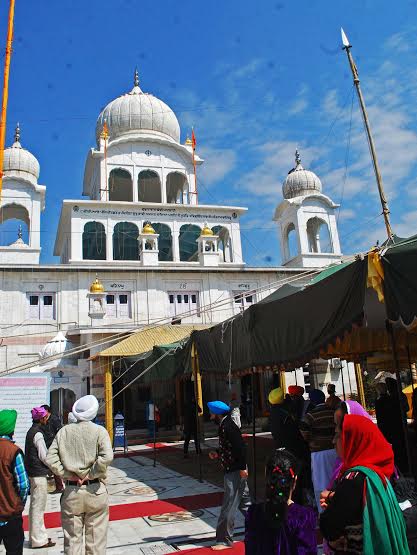
The shrine of Chatti Padshahi is dedicated to the sixth Sikh Guru Hargobind Sahab who travelled to various places to preach Sikhism. The Guru came to Kashmir also and stayed at the place which is now a Gurdwara. There is a ‘well’ known as Chola Asthan, which is considered holy by the community.
AKHUN MULLA SHAH
Situated on the slope of the Hari Parbat hill, below the Shrine of Makhdoom Sahib, this small mosque is believed to have been build by Dara Shikoh, son of Shah Jehan in 1649 A.D for his tutor Akhun Mulla Shah.
It has a domed roof, rectangular arched windows and walls made of grey limestone. On its lower side are the ruins of the arched halls wherein pilgrims used to stay. A little further off is the Hammam, which is now closed.
The mosque is closed for many years. A Turkish bath next to the mosque had been converted into a gym. Some of the windows of the mosque were replaced by new ones. However, the stone lotus finial over the pulpit still stays.
Hari Parbat
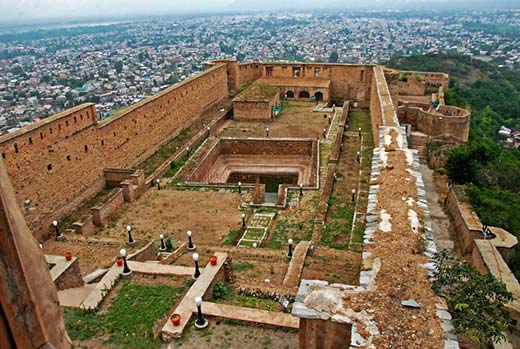
The hill of Hari Parbat also known as Koh e Maran crowned by the Pathan fort is visible from every part of city. It is the site of a Durrani fort, built-in 1808 by Afgan Governor Atta Muhammad khan. It has a famous Shakti Temple on the western slope and shrine of Khwaja Makhdoom Sahib and Akhund Mullah Shah Mosque on the southern slope.
For the last 22 years the fort has remained closed and has been thrown open for general visitors on April 22, 2007 for a few days. The fort remains out of bounds for general public since.
This government is planning to resume the lights and sound shows at the Hari Parbat this year. The show was a huge crowd puller when it was held, which is before the outbreak of armed militancy.
In 2009, it was developed as a heritage site and more than Rs 3 crore have been spent on its preservation.
SHARIKA MANDIR
The Temple of Jagadamba Sharika Baghati, is considered sacred by Kashmiri Pandits. Hindus belief regards her as the presiding deity of Srinagar city. The goddess, Sharika Devi is believed to be a form of goddess Durga or Shakti.
Badam Vaer (Almond alcove)
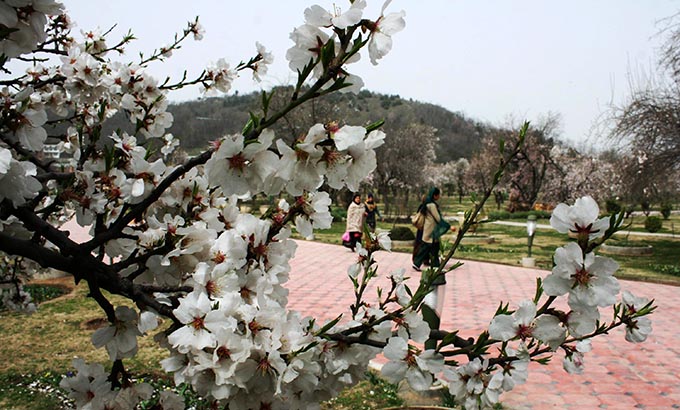
Ensconced in the foothills of koh e Maran, this garden was made during the reign of Dogra ruler Ranbir Singh. Historians, however, believe that Emperor Akbar used to spend leisure time in the garden. “The soothing atmosphere of the garden was liked by Emperor Akbar, and he often visited the garden,” the head of the history department, Professor Abdul Wahid said.
In late ’50’s and ‘60’s, thousands of people used to throng the garden which officially was opened on April 13. Cultural Programmes like buffoonery, music and dance held during the festival.
The Badam Vaer was in ruins until J&K Bank restored it. Tens of people can be seen taking a morning walk or jogging in there.
In the garden there is a well, known as Chah Waris khan, build by the administrator Waris Khan during Akbar’s reign. It was used for watering the trees and flowers in the garden.
Over the years popular greed saw encroachers building houses over the garden land.
Social activist and poet Zareef says, “The actual area of the garden, which Waris Khan made, stretched over to many kilometres. But now its area extends up to only a few Kanals.”





